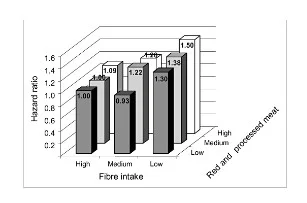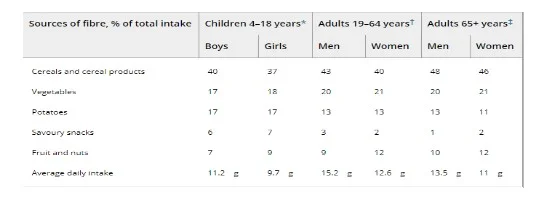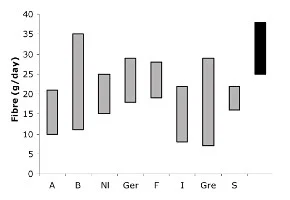Nutritional and health claim of fibre
Introduction:
Nutritional Health Claim:
The word “nutrition claim” describes any form of claim regarding the beneficial and nutritional aspects of the food such as the calorific value of the food which is provided either in the enhanced or reduced rate, the nutritional composition of the food, the ingredients that are present in higher or lower amount along with the presence or absence of other substances. Whereas the term “health claim” suggests about the existing relationship between the food sample or its constituents with the health condition of the individuals. The health claim may also indicate about the “reduction of disease risk claim” which describes the fact that consumption of that ingredient or food sample may potentially reduce the risk of developing that particular disease (Verhagen et al., 2010; Van Kleef et al., 2005). For those exploring these concepts in depth, healthcare dissertation help can provide valuable guidance in navigating this complex field.

Dietary Fibres:
The dietary fibres are the parts of the plants which are edible in nature and it contains mainly carbohydrates which cannot be digested or absorbed from the small intestine of human beings due to the lack of enzymes. These food substances undergo either complete or partial digestion or fermentation in the large intestine. The fibre is subdivided based on the physical properties such as whether it is soluble, insoluble or resistant in nature. The carbohydrates belong to the categories of Non Starch Polysaccharides (NSP) such as hemicellulose, cellulose, hydrocolloids (which includes mucilages, glucans and gums); resistant oligosaccharides such as galacto-oligosaccharides (GOS), fructo-oligosaccharides (FOS) and oligosaccharides (resistant in nature; 3-9 subunits); lignin and other plant substances. Resistant forms of starch such as physically enclosed starch, granules of raw starch, retrograded forms of amylose, physically and chemically modified starches are also included within the dietary fibres.
Soluble fibres: the fibres dissolve in water to form gel like materials and functions to reduce the blood glucose and cholesterol level. Their presence is found in oats, beans, peas, citrus fruits and barley.
Insoluble Fibre: the type of fibre augments the passage of the substance through the digestive system and increases the content of the stool so it can help those people who are facing constipation or irregularities in passing the stool. The insoluble fibres are available in the whole wheat flour, nuts, vegetables and potatoes (Buttriss et al., 2008).
Sources of Dietary Fibres:
Vegetables and the dish preparations of vegetables are considered to be the highest source of non starch based polysaccharides which can be consumed by all age groups which comprises of about the fifth of the intake among the children and a quarter intakes among the adults. Fruits are considered to be second source of dietary fibres among all the age groups. It provides about 13 -17% of dietary intake among the children who are aged below 10 years and 10-14% among the adults. The children who are aged within 11 -18 years group, the white bread, fried forms of potatoes and potato chips are considered to be the second largest sources of dietary intake approximately 10% of the dietary intake. Whole grain cereals, pasta, breads, oats, barley are fibre rich foods. The major contributors of dietary intake are pears, melons, oranges and berries among fruits and broccoli, carrots, potatoes with the skin and sweet corn are among the vegetables sources. The other sources are peas, pulses, beans and nuts (Buttriss et al., 2008).
The health benefits of high diet fibres:
The consumption of dietary fibres may provide a lot of health benefits:
The normalization of the movements of bowel:
The consumption of the dietary fibres softens the stool and also increases the size and weight of it. It helps in passing the stool thereby decreasing the chance of constipation and irregularities in the passing the stool. If the individual is suffering from watery or loose form of stool the intake of dietary fibres helps to solidify it and adds bulk to it. According to the findings of previous studies the intake of approx 25 gms/ day of dietary fibres from any mixed fruit sources (AOAC fibre or equivalent) is linked with the transit time of intestine which is approximately 2-3 days and the frequency of defecation was found to be 1/day with a moisture percentage in the faecal matter of 70%. The above conditions are considered to adequate for normal passing of stool among the adults (Anderson et al., 2009).
Helps in maintaining the bowel health:
The consumption of diet rich in dietary fibres helps in decreasing the risk of developing haemorrhoids and diverticular disease in the colon. Several studies had also established that the intake of dietary fibre decreases the risk of developing cancer in the colon and rectum. Some fibres also ferment in the colon and it also helps in prevention of the disease (Anderson et al., 2009).
Dietary fibre reduces the risk of colorectal cancer:
The intake of dietary fibre has been directly linked with the reduction of risk of colorectal cancer. Study conducted by the European Prospective Investigation on cancer highlighted that about 15 gms/day (lowest) and 35 gms/day (highest) intakes of dietary fibres resulted about 40% reduction in the risk of colorectal cancer. The protective effects can be correlated with the varied forms of fibres irrelevant of its source. This correlation has been supported by the World Cancer Research Fund (WCRF, 2007). Previous evidence had linked that increased consumption of processed meat to the prevalence of colorectal cancer. The increased risk of colorectal cancer due to the intake of red meat can be alleviated with the high intake of dietary fibres Previous research have demonstrated that the intake of whole grains or cereal fibres can reduce the chances of colorectal cancer, the daily intake ranges between 3.0-16.9 g/day. The researchers have also identified the major three biomarkers of the whole grains namely alkylresorcinol, avenacosides and benzoxazinoid-derived phenylacetamide sulphates (Refer Fig:1) (Kaczmarczyk et al., 2012; Anderson et al., 2009; Blundell et al., 1987; Jawhara et al., 2019; Aune et al., 2011).

ig: 1 correlation between the processed red meat and fibre consumption
Control obesity and enhances the life span:
The consumption of high fibre food keeps the stomach full for a longer period of time and it is lower in the energy content therefore the calorie intake also remains under control. Several research studies have also revealed that intake of cereal dietary fibres reduces the rate of mortality associated with cardiovascular diseases and all forms of cancers (Kaczmarczyk et al., 2012; Anderson et al., 2009).
Decreases the level of blood cholesterol:
The soluble fibres available within the food, helps to lower the level of blood cholesterol by decreasing the content of low density lipoprotein or “bad cholesterol” in the blood. Other studies have also highlighted that the consumption of fibre rich food helps in the reduction of the inflammation and blood pressure (Kaczmarczyk et al., 2012; Anderson et al., 2009).
Controls the blood sugar level:
Individuals suffering from diabetes when consumes the soluble fibres, it reduces the absorption rate of blood sugar and therefore improves the blood sugar level in the blood. A diet with dietary fibre (insoluble) content helps to control the condition of type 2 diabetes. Previous research studies had established that there is an inverse association between the intake of dietary fibres and risk of acquiring type 2 diabetes especially with the intake of cereal fibres. Individuals who consume a diet of high glycaemic index (GI) with low content of cereal fibres are at 75% higher risk of developing the type 2 diabetes than those who consumes the opposite diet (Refer Fig: 2).

Fig: 2 Relative risk of type 2 diabetes with the varied levels of intake of cereal fibres and the GI.
The diet plan rich in dietary fibres and whole grains might give protection against diabetic and pre diabetic state by augmenting the weight loss phenomenon. The intake of the dietary fibres helps in the improvement of glycemic control as established by the previous researchers (Kaczmarczyk et al., 2012; Anderson et al., 2009).
Cardiovascular diseases:
The intake of dietary fibres is inversely proportional to the risk of developing the Coronary Heart Disease (CHD). There is a reduction of around 14% in the risk of Coronary Heart Disease (CHD) with the consumption of 10 gms of dietary fibres/ day and the 27% decrease in the rate of mortality related to CHD. The inverse relationship between the CHD, stroke and the dietary intake is evident with the consumption of green leafy vegetables, Vitamin C rich fruits. Though the mechanism is not vivid, the reduction in the level of cholesterol by altering the cholesterol and the absorption of bile acids and the effect observed on the production of hepatic lipoprotein and synthesis of cholesterol are the underlying principles for the lowered risk of coronary heart disease (Kaczmarczyk et al., 2012).
Nutritional claims of dietary fibres:
The daily recommendations of dietary fibres:
Men who are younger than 50 years can consume 38 grams of dietary fibres and above the age of 51 years can consume about 30 grams of dietary fibres. Similarly women who are below 50 years can consume up to 25 grams and above the age of 51 years can consume about 21 grams of dietary fibres. The recommended intake of dietary fibres in the United Kingdom is around 18 grams per day (Department of Health, 1991). Though the limit of recommendation varies among different countries and it is based on different parameters still the recommended value in the UK is lowest within the whole world. A working group has been established by the Scientific Advisory Committee on Nutrition (SACN) of the government of United Kingdom to monitor the consumption of dietary carbohydrate and health related issues (Refer Table: 1 and Fig: 3).
Table: 1 Dietary carbohydrate intake recommendation in UK


Fig: 3 Comparison of dietary fibre intake among the European Countries
A, Austria; B, Belgium; F, Finland; Ger, Germany; GRE, Greece; I, Ireland; S, Spain.
In UK, the eatwell plate model (Refer Fig: 4) is considered to be the government’s advice on the topic of eating healthy. The plate consists of the two large portions that consist of food which acts as a source of dietary fibres. These fibres can be obtained from the source of starchy carbohydrates such as bread, rice, pasta, potatoes, cornmeal, etc. The consumers obtains the required information on healthy eating from the labelling on food items, the advice depending on the dietary reference values as mentioned as Guidelines Daily Amount (GDA), the “signposting” scheme namely the “traffic light scheme” of the Food Standards Agency in the United Kingdom. Moreover, recently there is confusion about the fibre content claim.

The Regulation on Nutrition and Health Claims guides about the claiming procedures in aspect of the fire content of the food if the level is higher than 3 gms /100gms or 6 gms/ 100 gms (high content of dietary fibres). Still there are no specific guidelines that are available on the aspect of methodology in relation to this context (Refer Table: 2).

Table: 2 Fibre content claims framework in Europe (values quoted are of AOAC)
It was evidenced from the statistics that mean of the intake of NSP among the adults were found to be 14gms /day. The Dietary Reference Values (DRV) for adults was 18 gms / day which is above the value mentioned in the guidelines of UK. The mean intake for the children under the age of 4 years was found to be 8 gms /day which is lower than 11 – 12 gms / day (Li et al., 2017).
Effect of food processing on the Dietary Fibre intake:
The process of grinding may affect the properties of hydration, particularly the kinetic involved in the uptake of water due to the increased surface area. The fibres get hydrated more rapidly. The process of heating also changes the ratio of soluble to insoluble fibres. The content of dietary fibre in a food sample is measured by the enzymatic-gravimetric method. Recently there is a demand from the consumers about the high fibre food samples but the physicochemical properties of fibres get altered due to the processing of food samples. The functioning of the fibre may also get enhanced. The techniques improve the following parameters such as the oil-holding capacity, physical and structural properties of hydration and viscosity (Dhingra et al., 2012).
Proposal for the new food development:
At least 25 gms of dietary fibre intake is recommended according to the guidelines that are followed in the UK (Department of Health, 1991). According to the author Dos Santos, the proposed diet should contain the whole food carbohydrate source, fresh vegetables should be included in the meal, popcorn or whole fruits in the snacks, the refined grains should be replaced with whole grains, chia seeds can be included in the diet. Whole grain toast or homemade muesli, seeds or nuts, oatmeal and berries or bananas among the fruits can be included in the breakfast menu. In the dinner half cup of lentils along with grilled fish, salads made of lettuce and carrots can be consumed. Skimmed milk should also be included in the diet.
The Proposals for the improvement of food processing:
With the fast changing times, the food processing industries are facing challenges for the improvement of food processing. Benchmarking can be used as a technique for improvement as it is a systematic process for critical analysis and improving the level of performance. It can be considered as a structured approach to learning and reaching the position of superiority by continuously monitoring the other companies. There are basically three types of processed foods: primary, secondary and tertiary. The traditional food processing has only two aims: to make the food easily digestible and to preserve the food during the time of scarcity. The modern food processing unit adds to the existing objectives such as: to keep the food microbiologically and chemically safe, to keep the product at highest quality and to make the food into a convenient form for use (Jain et al., 2006; Malik et al., 2014).
Conclusions:
Thus the present study discussed about the importance of nutrition claim and health claim of any food substances. The study especially focussed on the dietary fibre, its sources in our daily diet, the recommendation of intake of dietary fibres, the nutritional claims and the health benefits associated with the intake of dietary fibres. The significance of dietary fibres against the colorectal cancer, the cardiovascular disease, the bowel syndrome or the problem of constipation and against diabetes has been analyzed in details with the recommended doses that are preferred in this condition. This study also highlighted about the “eat well” plate model as per the government’s advice on the topic of eating healthy. The food processing techniques increasing the fibre content of the food and the changed properties have also been included in this topic.

Continue your journey with our comprehensive guide to Nutrition, Digestion and Excretion.
References:
Verhagen, H., Vos, E., Francl, S., Heinonen, M., & van Loveren, H. (2010). Status of nutrition and health claims in Europe. Archives of Biochemistry and Biophysics, 501(1), 6-15.
Van Kleef, E., van Trijp, H. C., & Luning, P. (2005). Functional foods: health claim-food product compatibility and the impact of health claim framing on consumer evaluation. Appetite, 44(3), 299-308.
Buttriss, J. L., & Stokes, C. S. (2008). Dietary fibre and health: an overview. Nutrition Bulletin, 33(3), 186-200.
Blundell, J. E., & Burley, V. J. (1987). Satiation, satiety and the action of fibre on food intake. International Journal of Obesity, 11, 9-25.
Anderson, J. W., Baird, P., Davis, R. H., Ferreri, S., Knudtson, M., Koraym, A., ... & Williams, C. L. (2009). Health benefits of dietary fiber. Nutrition reviews, 67(4), 188-205.
Kaczmarczyk, M. M., Miller, M. J., & Freund, G. G. (2012). The health benefits of dietary fiber: beyond the usual suspects of type 2 diabetes mellitus, cardiovascular disease and colon cancer. Metabolism, 61(8), 1058-1066.
Department of Health (1991) Dietary Reference Values for Food Energy and Nutrients for the United Kingdom, Report on Health and Social Subjects, No. 41. H.M. Stationery Office: London.
WCRF/AICR (World Cancer Research Fund/American Institute for Cancer Research) (2007) Food, Nutrition, Physical Activity, and the Prevention of Cancer: A Global Perspective. AICR: Washington, DC.
Li, Y. O., & Komarek, A. R. (2017). Dietary fibre basics: Health, nutrition, analysis, and applications. Food quality and safety, 1(1), 47-59.
Dhingra, D., Michael, M., Rajput, H., & Patil, R. T. (2012). Dietary fibre in foods: a review. Journal of food science and technology, 49(3), 255-266.
Jawhara, M., Sørensen, S. B., Heitmann, B. L., & Andersen, V. (2019). Biomarkers of Whole-Grain and Cereal-Fiber Intake in Human Studies: A Systematic Review of the Available Evidence and Perspectives. Nutrients, 11(12), 2994.
Aune, D., Chan, D. S. M., Lau, R., & Vieira, R. greenwood, DC, kampman, E., Norat, T., 2011. Dietary fibre, whole grains, and risk of colorectal cancer: systematic review and dose-response meta-analysis of prospective studies. Brifish Medical Journal, 343, d6617-d6617.
Jain, R., & Yadav, O. P. (2006). Driving improvement opportunities in the food processing industry through benchmarking. International Journal of Process Management and Benchmarking, 1(4), 352-369.
Malik, A., Erginkaya, Z., Ahmad, S., & Erten, H. (Eds.). (2014). Food processing: strategies for quality assessment. Springer.
Dos Santos, H., & Gonzalez, N. Fiber, the Ultimate Diet. Clin Nutr, 34(4), 603-611.
- 24/7 Customer Support
- 100% Customer Satisfaction
- No Privacy Violation
- Quick Services
- Subject Experts



